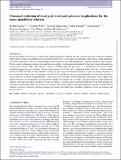Files in this item
Chemical evolution of local post-starburst galaxies : implications for the mass-metallicity relation
Item metadata
| dc.contributor.author | Leung, Ho-Hin | |
| dc.contributor.author | Wild, Vivienne | |
| dc.contributor.author | Papathomas, Michail | |
| dc.contributor.author | Carnall, Adam | |
| dc.contributor.author | Zheng, Yirui | |
| dc.contributor.author | Boardman, Nicholas Fraser | |
| dc.contributor.author | Wang, Cara | |
| dc.contributor.author | Johansson, Peter H. | |
| dc.date.accessioned | 2024-02-22T15:30:03Z | |
| dc.date.available | 2024-02-22T15:30:03Z | |
| dc.date.issued | 2024-03 | |
| dc.identifier | 294622921 | |
| dc.identifier | 766f3f97-22c7-4df9-b4f9-dbdbc9bc0267 | |
| dc.identifier | 85184380038 | |
| dc.identifier.citation | Leung , H-H , Wild , V , Papathomas , M , Carnall , A , Zheng , Y , Boardman , N F , Wang , C & Johansson , P H 2024 , ' Chemical evolution of local post-starburst galaxies : implications for the mass-metallicity relation ' , Monthly Notices of the Royal Astronomical Society , vol. 528 , no. 3 . https://doi.org/10.1093/mnras/stae225 | en |
| dc.identifier.issn | 1365-2966 | |
| dc.identifier.other | ORCID: /0000-0003-0486-5178/work/153977531 | |
| dc.identifier.other | ORCID: /0000-0002-5897-695X/work/153977839 | |
| dc.identifier.uri | https://hdl.handle.net/10023/29331 | |
| dc.description.abstract | We use the stellar fossil record to constrain the stellar metallicity evolution and star-formation histories of the post-starburst (PSB) regions within 45 local PSB galaxies from the MaNGA survey. The direct measurement of the regions’ stellar metallicity evolution is achieved by a new two-step metallicity model that allows for stellar metallicity to change at the peak of the starburst. We also employ a Gaussian process noise model that accounts for correlated errors introduced by the observational data reduction or inaccuracies in the models. We find that a majority of PSB regions (69 per cent at >1σ significance) increased in stellar metallicity during the recent starburst, with an average increase of 0.8 dex and a standard deviation of 0.4 dex. A much smaller fraction of PSBs are found to have remained constant (22 per cent) or declined in metallicity (9 per cent, average decrease 0.4 dex, standard deviation 0.3 dex). The pre-burst metallicities of the PSB galaxies are in good agreement with the mass–metallicity (MZ) relation of local star-forming galaxies. These results are consistent with hydrodynamic simulations, which suggest that mergers between gas-rich galaxies are the primary formation mechanism of local PSBs, and rapid metal recycling during the starburst outweighs the impact of dilution by any gas inflows. The final mass-weighted metallicities of the PSB galaxies are consistent with the MZ relation of local passive galaxies. Our results suggest that rapid quenching following a merger-driven starburst is entirely consistent with the observed gap between the stellar mass–metallicity relations of local star-forming and passive galaxies. | |
| dc.format.extent | 24 | |
| dc.format.extent | 11341033 | |
| dc.language.iso | eng | |
| dc.relation.ispartof | Monthly Notices of the Royal Astronomical Society | en |
| dc.subject | Methods: statistical | en |
| dc.subject | Galaxies: abundances | en |
| dc.subject | Galaxies: evolution | en |
| dc.subject | Galaxies: starburst | en |
| dc.subject | Galaxies: stellar content | en |
| dc.subject | QC Physics | en |
| dc.subject | DAS | en |
| dc.subject.lcc | QC | en |
| dc.title | Chemical evolution of local post-starburst galaxies : implications for the mass-metallicity relation | en |
| dc.type | Journal article | en |
| dc.contributor.institution | University of St Andrews. School of Physics and Astronomy | en |
| dc.contributor.institution | University of St Andrews. Statistics | en |
| dc.contributor.institution | University of St Andrews. Centre for Research into Ecological & Environmental Modelling | en |
| dc.identifier.doi | https://doi.org/10.1093/mnras/stae225 | |
| dc.description.status | Peer reviewed | en |
This item appears in the following Collection(s)
Items in the St Andrews Research Repository are protected by copyright, with all rights reserved, unless otherwise indicated.

